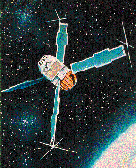|
|
The Uhuru Satellite

huru, also known as the Small Astronomical
Satellite 1 (SAS-1) was the first earth-orbiting mission dedicated
entirely to celestial X-ray astronomy. It was launched on 12 December
1970 from the San Marco platform in Kenya. December 12 was
the seventh anniversary of the Kenyan independence and in recognition
of the hospitality of the Kenyan people, the operating satellite was named
Uhuru, which is the Swahili word for freedom.
The mission operated over two years and ended in March 1973.
Mission Characteristics
 Lifetime : 12
Dec 1970 - March 1973 Lifetime : 12
Dec 1970 - March 1973
 Energy Range : 2-20 keV
Energy Range : 2-20 keV
 Payload :
Two sets of proportional counters, 2-20 keV 0.084 m2 Payload :
Two sets of proportional counters, 2-20 keV 0.084 m2
 Science Highlights:
Science Highlights:
- First comprehensive and uniform all sky survey
with a sensitivity of 10-3 the Crab intensity.
- The 339 X-ray sources detected are binaries, supernova remnants, Seyfert
galaxies and cluster of galaxies
- Discovery of the diffuse X-ray emission from clusters of galaxies
 Archive : 4th Uhuru Catalog
Archive : 4th Uhuru Catalog
Photograph of Uhuru satellite courtesy of SAO.
[About Uhuru] (http://heasarc.gsfc.nasa.gov/docs/uhuru/uhuru_about.html)
[Archive] (http://heasarc.gsfc.nasa.gov/docs/uhuru/archive/uhuru_archive.html)
[Gallery] (http://heasarc.gsfc.nasa.gov/docs/uhuru/uhuru_images.html)
[Publications] (http://heasarc.gsfc.nasa.gov/docs/uhuru/bib/uhuru_biblio.html)
|
